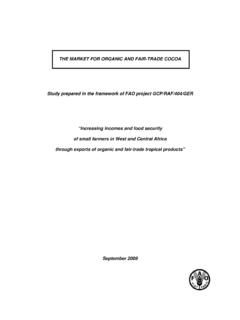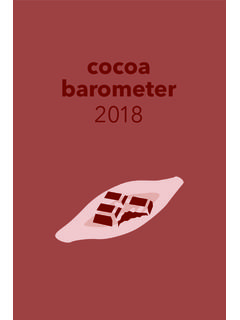Transcription of 2 Seed Moisture: Recalcitrant vs. Orthodox Seeds
1 2 Seed Moisture: Recalcitrant Seeds 'H. F. Chin and B. KrishnapillayUniversiti Pertanian MalaysiaSelangor, MalaysiaP. C. StanwoodUSDA -ARSFort Collins, ColoradoThe terms Orthodox and Recalcitrant Seeds came into usage in 1973. Roberts(1973) classified these Seeds according to their physiological Seeds were those Seeds that could be dried to low moisture content( , g H2 0 g' fresh wt., fw)2 and tolerated freezing 's rule of thumb (1972) states that between and g H2Og ' fw if the seed moisture content is increased by 1 Wo ( g H20 g' fw),the life span of Orthodox Seeds will be reduced by 50%. Recalcitrant seedscould not be dried below a relatively critical moisture content ( , gH2O g' fw) and could not tolerate freezing temperatures.
2 Because of thesedifferences, Hanson (1984) suggested that the term desiccation sensitive moreaccurately described Recalcitrant Seeds . Recalcitrant Seeds lose viability oncethey are dried to a moisture content below a relatively high critical means that seed moisture is a critical factor determining the viabilityand longevity of both Recalcitrant and Orthodox this reason, one must first identify the seed type before prescribinga method of storage. Orthodox Seeds require low ( , g H2O g 1 fW)seed moisture content for successful long-term storage. In contrast, re-calcitrant Seeds must be stored at relatively high moisture levels ( , H20 g' fw).
3 As a result, the methods, techniques, packaging materials,containers, and the storage environment must be modified for successfulstorage of these Seeds . In this chapter, determination of Recalcitrant seedsmoisture content is described and discussed. In addition, differences betweenrecalcitrant and Orthodox seed structure, morphology, and physiology arereviewed with particular emphasis on seed moisture content.'Contributions from the Agronomy and Horticulture Dep., Universiti Pertanian Malaysia,43400 Serdang, Selangor, Malaysia and National Seed Storage Laboratory, USDA-ARS, Col-orado State Univ., Fort Collins, CO 80523, T convert (g H20 g fw) to (01o), multiply by 100.
4 Thus, g H20 g' fw = 1989 Crop Science Society of America, 677 S. Segoe Rd., Madison, WI 53711,USA. Seed Moisture, CSSA Special Publication no. CHIN ET DETERMINATIONThe International Seed Testing Association (ISTA) has published rulesfor the determination of Orthodox seed moisture content, which have changedconsiderably from 1931 to 1985 (Grabe, 1987). In the latest version (ISTA,1985), two samples of Seeds are used for the determination of seedmoisture content. High and low temperature air-oven methods of 130 to133 C and 101 to 103 C are recommended for non-oily and oily Seeds , respec-tively. If Seeds are large, , maize (Zea mays L.)
5 , ground samples are re-quired. The duration of the test for the high-temperature method is 1 to 4h; for the low-temperature method, the duration is 16 to 18 tree Seeds , ISTA (1966) recommended the air-oven method at 101to 105 C except for Abies, Cedrus, Fagus, Picea, and Tsuga for which thetoluene-distillation method could be used. Bonner (1972) concluded that theair-oven method at 130 C for 4 h followed by 2 h of cooling in a desiccatorprovided accurate results for Seeds of such North American hardwoods asPlan (anus occidentalis L., Liquidambar styracifona L., and Fraxinus penn-sylvanica , there are still no rules for drying methods for Recalcitrant those Seeds are typically large and heavy, drying samples are notadequate in size, which makes sampling difficult.)
6 The number of Seeds thatshould be tested to obtain a statistically reliable drying method has yet tobe determined. It should also be emphasized that most Recalcitrant Seeds aresold by number and not by weight. Hence, the economics of seed numberfor testing and the number of Seeds available for an experiment should bekept in mind. According to Cochran (1953) and Mok (1972), the optimumsample size for large Recalcitrant Seeds should be approximately 20 the sample size is obtained, the typical method for determining moisturecontent of Recalcitrant Seeds is to cut seed cross sections. These sec-tions are placed in an oven at 101 to 105 C for 16 h.
7 Using whole Seeds ,halving or quartering the Seeds produces more variable seed moisture BETWEEN Recalcitrant ANDORTHODOX SEEDSR ecalcitrant and Orthodox Seeds differ greatly in their ecology andmorphology. Recalcitrant Seeds are primarily from perennial trees in the moisttropics. In some cases, they also come from temperate tree or aquatic species,while most Orthodox Seeds are from annual species grown in open respect to morphology, Recalcitrant Seeds differ from orthodoxseeds not only in size but also complexity and viability. Many recalcitrantseeds for example, are not true Seeds but exist as fruits, an example beinga fibrous drupe in the case of coconuts (Cocos nucifera L.)
8 Generally, Recalcitrant Seeds are covered with fleshy or juicy arilloid layers and im-permeable testa. These maternal structures maintain the Seeds in a high-moisture environment. Recalcitrant Seeds also have greater variation in theRECALCITRANT AND Orthodox Seeds 17shape and size of cotyledons and the embryonic attachment compared to bean(Phaseolus vulgaris L.), a typical example of an Orthodox Content of Recalcitrant and Orthodox SeedsAt physiological maturity, the moisture contents of Recalcitrant Seeds ( g H20 g -' fw) are much higher than Orthodox Seeds ( H20 g -' fw). At the same time, Recalcitrant Seeds are larger (42 x 25 mm)and heavier, an average of g per seed for durian (Durio zibethinus Murr.)
9 Typical differences in seed size, 1000 seed weight, and moisture content ofrecalcitrant and Orthodox Seeds are presented in Table 2-1. Orthodox seedsundergo drying after physiological maturity: initially, the moisture contentis high ( g H2O g 'fw), but they then will dry to a harvest moisturecontent of to g H2O g' fw).Although Recalcitrant Seeds are large, their embryos in relation to thewhole seed are only about 15% of the size of those for Orthodox Seeds . Typicalexamples of the proportion of the total seed dry weight for the cotyledons,testa and embryos of Recalcitrant and Orthodox Seeds are given in Table 2-1.
10 Seed size, 1000 seed wt., and moisture content of typical Recalcitrant andorthodox size, 1000 MoistureCrop species length x width Seed wt. contentRecalcitrant mm g gH2Og'fwNephelium lappaceum L. 28 x 16 3 555 heterophyllus Lam. 35 x 24 8 520 champeden (Lour.) Spreng. 30 x 20 5 814 domesticum Corr. 17 x 13 2 335 ganadaria 22 x 15 3 530 zibethinus Murr. 42 x 25 14 783 cacao L. 25 x 25 1 995 esculentus L. 6 x 4 146 sesquipedalis (L.) Fruw. 12 x 5 192 2-2. The percentage dry weight for the cotyledons, testa, and embryo of orthodoxand Recalcitrant speciesOrthodoxPisum satioum oulgaris max (L.)






